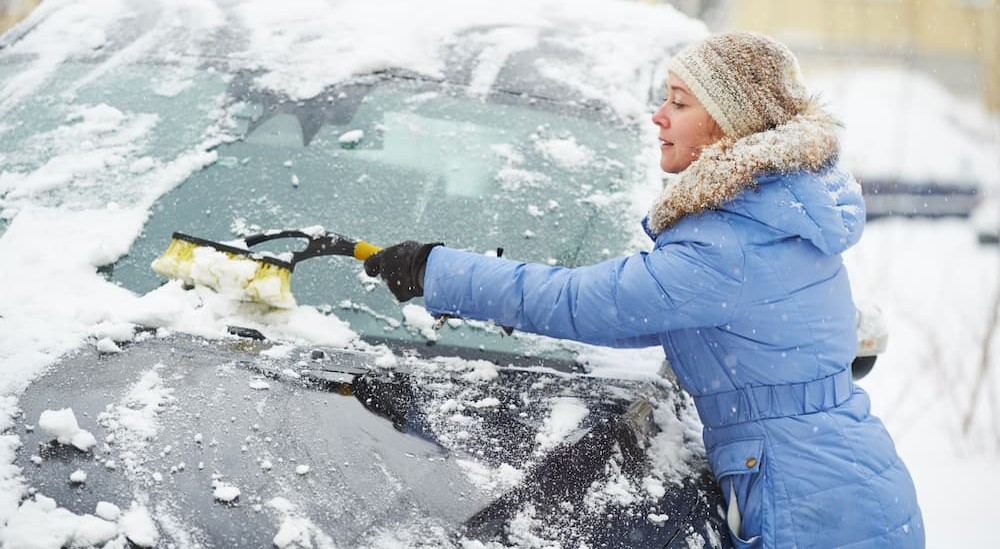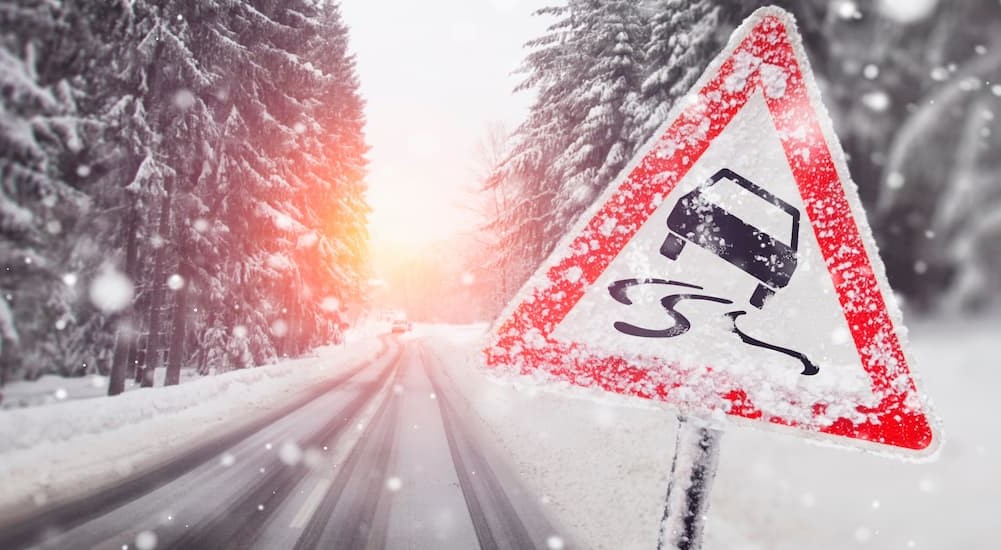Everyone on the road loves the holidays a lot,
but cold weather can put drivers in a tough spot.
Most drivers hate snow, ice, and road salt,
which can bring your Christmas travel plans to a halt.
It could be you don’t know your way around a shovel,
or think clearing your roof is just too much trouble.
Some think that snow tires are just a suggestion,
which can cause a big headache, like sinus congestion.
Salt can turn your car into a rusty old hulk,
And cause corrosion that just makes you sulk.
If your battery isn’t up to the task,
you might end up stranded and in your ski mask.
If you want to struggle through this chilly season,
I’ve got a few tips that defy all good reason.
Read on as I share some bad winter advice,
That’ll leave you cold, late, and slipping on ice.
Don’t Remove Ice and Snow
It’s a common, if unfortunate, sight during the winter months: a car speeding down the road with a thick layer of snow on the roof while the driver navigates traffic through a small, porthole-sized clearing. We all know what it’s like to be in a hurry during the morning, and the issue is often exacerbated when your day starts off with 45 minutes of vigorous shoveling to free your car from the driveway. That’s no excuse for endangering yourself or others from behind the wheel of an abominable snow van, car, or truck. Clearing snow and ice off your roof, windshield, and windows isn’t just a good idea. It’s legally required in many northeastern and Midwestern states. Alaska, Connecticut, Georgia, Maine, Massachusetts, Michigan, New Hampshire, New Jersey, Pennsylvania, Rhode Island, Tennessee, and Wisconsin all have laws on the books regarding conspicuously snowy vehicles, so make sure to read up on your local laws before trying to shave a few minutes off of your morning commute.
Forget About Your Undercarriage
They say rust never sleeps, and it certainly doesn’t hibernate for the winter. The road salt used to keep streets free of ice can accelerate corrosion and potentially make your undercarriage look like an expensive slice of Swiss cheese. Rust is not only unsightly and detrimental to a vehicle’s resale value, but it can also lead to some serious safety-related concerns. It even has the potential to total a vehicle. This is why paying a little extra attention to your undercarriage during the colder months is important.
When the snow plows and salt-spreading trucks start to hit the road, it’s time to hit the car wash. Using a basic high-pressure rinse can help to remove the brunt of dried-on road salt, but there are also plenty of specialty products, coatings, and other forms of protection on offer. You should try to give your undercarriage a good rinse every week or two, though you’ll want to avoid breaking out the hose when the temperature drops below the freezing point, and ice buildup leads to its own problems. While the undercarriage might be the most susceptible to corrosion, drivers should also make sure to give the wheel wells a good rinse while they’re at it.

Ignore the Battery
Batteries and cold weather just don’t mix. You’ve probably seen the viral headlines over the last few years regarding EVs that are efficiently turned into stationary objects during extreme cold snaps. Many drivers don’t realize that even gas-powered vehicles are susceptible to the same temperature-related risks. The 12-volt batteries used to power most of today’s cars, trucks, and SUVs can lose between 30 and 60 percent of their power when the thermometer drops below freezing due to a slowdown in its chemical reaction. This loss of power can lead to some real headaches when trying to start your car on a cold winter morning, but the problem can be easily addressed by adhering to some good habits.
Keeping a vehicle stored in a warmer environment like a garage or using a battery warmer can help make smoother starts. So can cleaning the battery terminals and avoiding short trips that drain the battery without giving it adequate time to recharge. Drivers should also pay attention to a battery’s Cold Cranking Amps (CCA) rating, which reflects a battery’s ability to start the engine in low temperatures. A 600 CCA rating is generally regarded as a good rating, but it all depends on the weather conditions and the size of the vehicle and engine. A small car might be able to get away with a lower CCA rating of around 400, while larger trucks and SUVs could require a CCA rating of 800 or higher.
Don’t Use Winter Tires
There’s nothing like strapping on a pair of skates and gliding across a frozen pond in the middle of the winter. A low-friction experience is much less fun when on a busy road or steep, snowy hill. Modern traction control and all-wheel drive systems have dramatically improved our ability to tackle slick wintery surfaces, but there’s still no substitute for a good set of snow tires. Studies have shown that the right set of rubber can reduce the likelihood of an accident by as much as five percent, yet winter tire usage is actually relatively rare among US drivers. Only around 16 percent of drivers in snowy states tend to swap out their regular tires for snow-specific replacements in any given year, which lags far behind countries like Germany (40 percent), Switzerland (over 50 percent), and Canada (61 percent), whose Province of Quebec legally requires snow tires between December 1 and March 15.
Many drivers cite the cost and hassle of changing over their tires as the main deterrent, but it’s hard to argue against snow tires. Designed with rubber compounds specifically designed to resist the sort of hardening that can lead to a loss of traction and built with larger tread blocks that maintain a firm grip on the road while expelling caked-on snow and ice, snow tires go a long way towards improving confidence and safety when you’re behind the wheel. Snow tires do have their disadvantages. They tend to impact fuel economy and cause a great deal of noise when driving on dry pavement. However, they’re well worth the cost in time and money when you consider the potential benefits.

Don’t Swap Out Your Wipers
Drivers might not spend too much time thinking about their wiper blades, but few components can have quite as much of an impact on road safety. This is especially true during the winter when snow, sleet, and freezing rain can conspire to obscure your view on the road. Many experts recommend switching out your normal wiper blades for a dedicated set of winter wipers when the white stuff starts to fly. Regular wipers can easily become clogged with snow and ice, which impacts their ability to clear the windshield effectively and can lead to some significant blind spots. Winter wipers feature a more robust design with a helpful rubber boot surrounding the entire blade to prevent caked-on ice and snow. Springing for a set of winter wipers can also help you extend the life of your normal blades, though it’s generally recommended to perform a replacement every six months regardless of your rotation schedule. Drivers should also keep on top of their wiper fluid during the winter and invest in a freeze-resistant formula that can withstand low temps.
Forget About an Emergency Kit
All the preparation in the world can’t entirely eliminate the possibility of a mid-winter accident or breakdown, which is why ensuring you’re prepared for every eventuality is important. While a good roadside emergency kit is an essential part of any driver’s arsenal, it’s especially vital during the winter months. No driver should leave home without a set of jumper cables, a small tool kit, a basic first aid kit, road flares or warning lights, and a little extra oil, coolant, and wiper fluid. Some important winter-specific additions should find their way into the trunk. A flashlight and candle-powered heater can keep you warm and illuminated without draining the gas tank or battery, while a shovel, recovery boards, and sand or a bag of cat litter can aid in increasing traction and freeing you from a sticky spot. Drivers should also pack a spare set of winter clothes, a warm blanket, some emergency rations, and water.
In addition to maintaining a well-stocked emergency kit, try to keep the gas tank at least half-full during the winter. There are two reasons for this. First, more gas in the tank means less room for condensation, which can easily cause the gas lines to freeze. Secondly, it’s never a bad idea to have a little extra fuel in the tank if you find yourself stranded on the side of the road. Running the engine can help you keep the cabin warm until help arrives or charge devices that can be used to contact emergency services or roadside assistance.
From thoroughly removing built-up ice and snow to regularly cleaning your undercarriage and replacing your battery with one that boasts a higher CCA rating, a driver can take plenty of steps to improve their fortunes when facing winter weather. Swapping your all-season tires for a proper set of snow tires is one of the easiest ways to improve traction and safety, but even something as simple and affordable as buying a new set of winter wiper blades can make a big difference in the overall driving experience. No driver looks forward to running off the road or breaking down on a dark winter’s night, but a well-stocked emergency kit can prevent the situation from becoming a downright catastrophe. A little time spent prepping your vehicle for the winter months can make all the difference when disaster strikes, helping drivers avoid some of the worst outcomes and growing their chances of success by three sizes.

